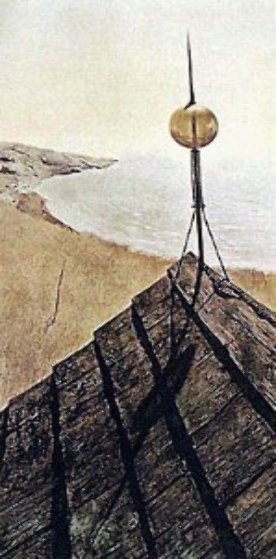Brandywine River Museum of Art
June 24 through September 17, 2017
Seattle Art Museum
October 19, 2017 through January 15, 2018
Andrew Wyeth: In Retrospect, a once-in-a-lifetime exhibition of iconic works by this master painter, commemorates the centennial of the artist’s birth. It will include over 100 works spanning his entire career, from the early works that quickly established his reputation to his final painting, Goodbye, completed months before his death in 2009. The Brandywine is the only East Coast venue for the exhibition and the only location where visitors can immerse themselves in the world of Wyeth through tours of his studio and Kuerner Farm. Public tours of these locations add insight to his work offering an intimate look at the personal space of this very private artist and an opportunity to see the farm, which inspired nearly 1,000 works of art.
Wyeth’s life extended from World War I—a period that sparked the imagination of the artist as a young boy—to the new millennium. He once said that painting to him was “following a long thread leading like time to change and evolution.” This comprehensive retrospective follows that thread over the decades as it unwinds, progressing forward and at times altering course. The exhibition will offer new interpretations of his work, noting the significance, for example, of such influences as popular film and images of war, and on the relatively unstudied but numerous portrayals of African Americans from the Chadds Ford community. Visitors will also be given a view into Wyeth’s working process through studies rarely exhibited in the artist’s lifetime and through comparisons of Wyeth’s widely divergent approaches to watercolor—which inspired him to paint quickly and with abandon at times—and to tempera—a more controlled medium in which he built up paint slowly and deliberately.
Co-organized by the Brandywine River Museum of Art and the Seattle Art Museum, Andrew Wyeth in Retrospect examines four major periods in the artist’s career:
1935-1949: This section looks at Wyeth’s emerging presence in the art world—from the colorful, expressive watercolors of the Maine coast that reveal a debt to Winslow Homer and brought him to the attention of the art world in the late 1930s, to his early forays into the medium of tempera, and to the powerful, dramatic works of the mid to late 1940s.
Highlights include Lobsterman (1937), painted the summer before his first, momentous New York show;
his early temperas, such as Frog Hunters (1941)—which was featured in the landmark Museum of Modern Art show, Americans 1943: Realists and Magic Realists;
and the now iconic works—such as Winter 1946 (1946)—that were crafted after October 1945, when the death of his father caused a profound shift in Andrew Wyeth’s outlook on his art.
1950-1967: By 1950, Wyeth’s attention was focused on his own visceral responses to the landscape around his home in Chadds Ford, and Maine, most particularly the Christina Olson property and the coastline. Wyeth divided his time between these places. In Chadds Ford, he painted the Kuerner Farm (now part of the Brandywine River Museum of Art), which was long at the center of Wyeth’s world there and forever linked in his mind to the nearby railroad crossing where his father, N.C. Wyeth, had met a tragic death. He also painted friends who were the last of the Black community that had been established in Chadds Ford during the Civil War. In Maine, Wyeth expressed his compelling emotional connection to the siblings Christina and Alvaro Olson and their house and property in Cushing.
Significant works from this period include
Northern Point (1950);
Miss Olson (1952);
and Spring Fed (1967).
Examples of Wyeth’s extensive studies in pencil and watercolor of his African American subjects
Tom Clark,
Adam Johnson, and
Willard Snowden (The Drifter, 1967), are also included.
1968-1988: By now one of America’s most famous artists, in 1968 Wyeth began to explore the realm of erotic art. This is the period that saw his first extended series of nudes, of the adolescent Siri Erickson in Maine and of Helga Testorf in Chadds Ford. The paintings of Helga, famously kept secret by the artist until the mid-1980s, when their revelation created a national sensation, have occupied an outsize place in the narrative of Wyeth’s multi-decade career. The exhibition will show that while he was working on these nude subjects, he also painted for public view some of his most psychologically complex, symbolically rich, and compositionally ambitious works. Highlights include the now iconic paintings focused on his neighbors, the Kuerners: examples are
Evening at Kuerners (1970);
The Kuerners (1971);
and Spring (1979).
1989-2009: Beginning in 1989, Wyeth’s work became particularly self-reflective as he looked backward—partly in response to the critical backlash he experienced from the revelation of the Helga paintings. His late works are often infused with mystery and a surreal quality, recalling his earliest work and at times, in fact, directly referencing it.
Highlights include the large tempera Snow Hill (1989), filled with autobiographical allusions,
and Goodbye (2008), a painting completed just months before his death that has not been widely seen or published.
The catalogue accompanying the exhibition will be co-published by Yale University Press, the Brandywine River Museum of Art and the Seattle Art Museum. It will provide a full visual document of the works in the exhibition, as well as lay out the first detailed timeline of Wyeth’s career. In addition to Patricia Junker’s insightful contextual analysis of the four periods described above, the catalogue will include seven provocative essays on key aspects of Wyeth’s work by scholars from both the United States and Japan. The catalogue is intended to be a foundation for subsequent Wyeth studies.
The co-curators for the exhibition are Audrey Lewis, Curator, Brandywine River Museum of Art, and Patricia Junker, the Ann M. Barwick Curator of American Art at the Seattle Art Museum. The exhibition will be on view at the Seattle Art Museum from October 19, 2017 through January 15, 2018.













